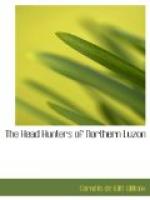Our journey was without incident; it did not, much to my disappointment, include the side trip sometimes made to the Babuyanes Islands for cattle. One of these islands, Fuga, is especially interesting; urn-burial prevailed in it in the past, the urns in some cases being arranged in a circle around a central urn or altar. Moreover, there is in Fuga a stone building known as the “Castle,” with arched doorways, said not to be of Spanish origin, and near by is a plain strewn with human skulls and other bones, probably the scene of a battle. The skulls are remarkable from their great size, some of them being reported as extraordinary in this respect. The present inhabitants of these islands and of the Batanes live in stone houses, much like those of North Ireland and the islands west of Scotland. [44] And so we had hoped, Campbell and I, that we might get at least a look at Fuga. For, although it lies near to Aparri, it is hard to reach; small boats, even on calm, smooth days, being occasionally caught in the wicked currents of these waters and swamped out of hand. The next morning we made Kurrimao, which has a shore-line strikingly picturesque in a land almost surfeited with the picturesque. We stayed long enough to take on a number of carabaos, which were swum out to the ship, and then hauled out of the water by a sling passed around their horns.
Our next stop was at Vigan, a well-built town, many of whose houses are of stone. We reached the town in a motor-car, passing through well cultivated fields of maguey. The mountains, rising abruptly from the coastal plain, are here cut by the famous Abra de Vigan, a conspicuous gap serving as a land-mark to the mariner for miles. And it is the custom to take a ride of many hours up the pass, and then come down the rapids in two, on bamboo rafts built for the purpose. This is a most exciting trip; alas! we had to be contented with an account of it! But Vigan itself was worth the trouble of going ashore; its churches and monasteries are extensive, dignified of appearance, and far less dilapidated than is unfortunately so frequently the case elsewhere in the Islands. Not the least interesting item of our very short stay was a visit to a new house, built and owned by an Ilokano, and equipped with the most recent American plumbing. The house itself happily was after the old Spanish plan, the only one really suited to




